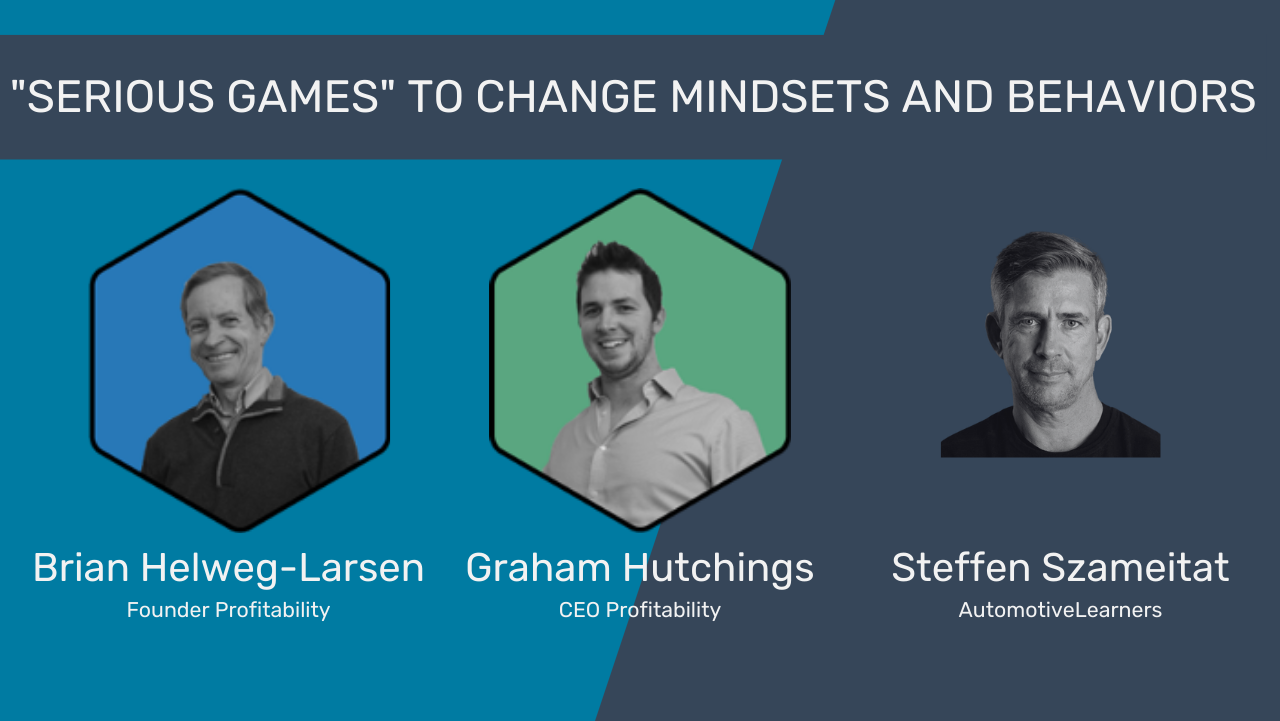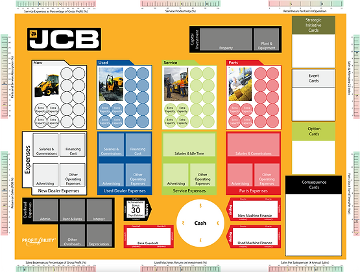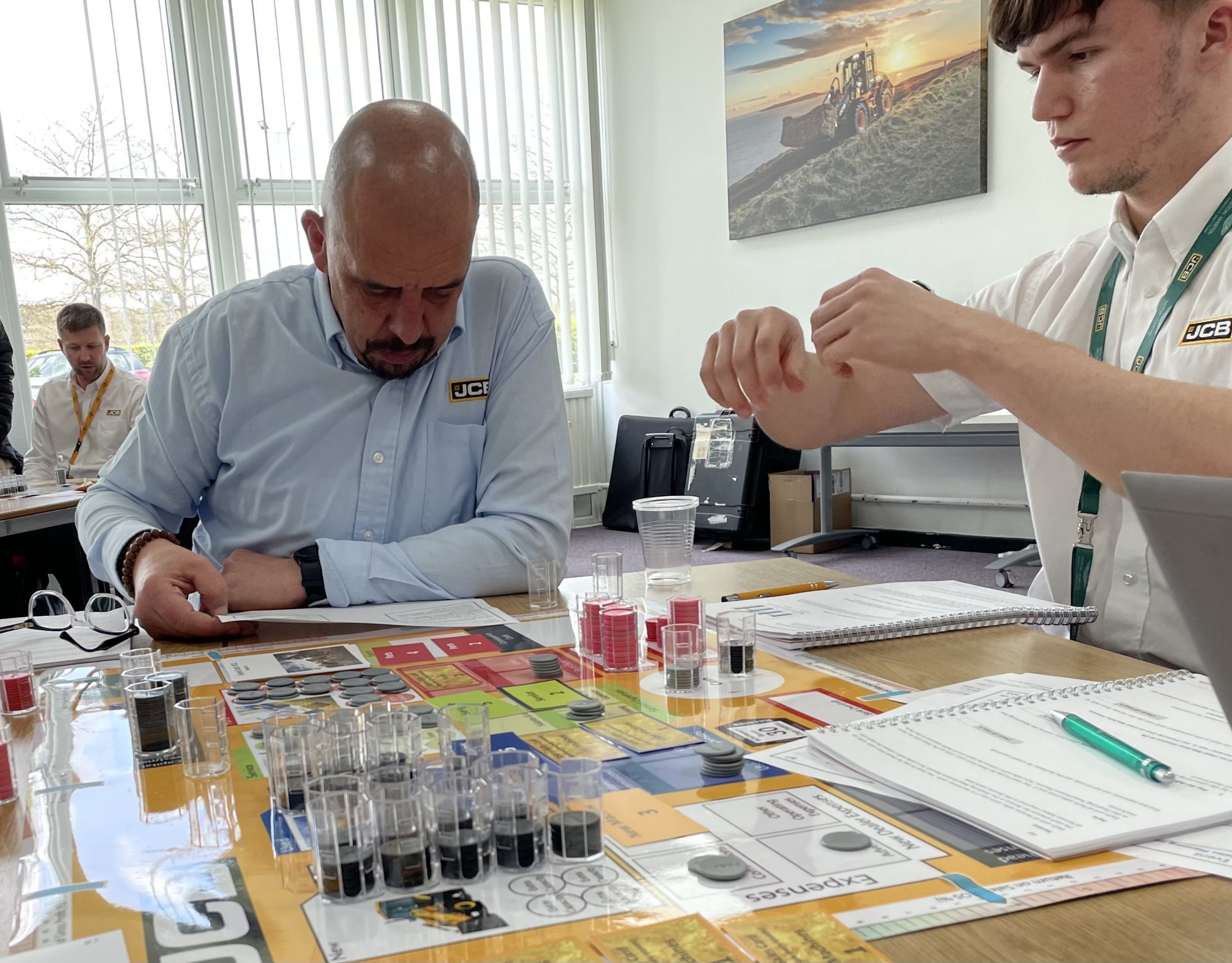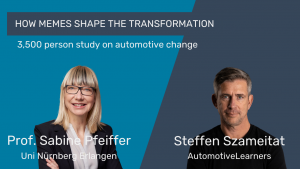Reading time: 13 minutes
Fun and games, according to conventional wisdom, have no place in the business world.
“Serious games” or business simulations, on the other hand, can be effective in changing attitudes, shaping mindsets, and learning new behavior – all of which are crucial for survival in the automotive transition.
As an automotive manager, I’d want to build a case for more “serious games” in the automobile sector. Profitability, a British team developing and delivering business simulations since 1983, invited me to participate to have a firsthand experience of a business simulation.
I spoke with founder Brian Helweg-Larsen and Graham Hutchings, CEO of Profitability.com.
Simulations, such as war games, are used for high-stakes decisions. What exactly are “serious games”?
Brian: A “serious game” is one that has serious learning outcomes baked into its fabric.
For instance, if you play the role of a team in a crisis, the behaviors shown in the game provide a direct example of behaviours that might be shown in real life, good or bad, but without the grave consequences attached. By reflecting on them, participants can learn about their own behaviors, and benefit by reacting differently in real situations.
Was there a point in your life when you became aware of “serious games”?
Brian: I first came across serious games in the late 1970s when GEC (General Electric Company), then the biggest company in the UK, used them in management development. I saw the impact they had on self-awareness, and the high engagement they created.
I first worked with simulations that other people had developed. I started tailoring and changing the ones that were on the market so that they would fit the learning objectives that I had. Then I decided to start building my own simulations, nearly 40 years ago. So, I have built something like 180 simulations over the last 40 years. Many are financial board games, but some have gone in completely different directions to help people understand managing change, for instance, or to build leadership skills or to get feedback on their personal interaction with others to encourage inclusive leadership.
We have created a wide range of serious games for business acumen, change management, leadership and teamwork skills, ESG awareness, Talent management and Inclusive Management.
The consistent theme is people learning by doing rather than endless passive e-Learning or suffering “death by Powerpoint”, which is how a lot of training (but very little learning) still happens. Because if somebody learns something in a simulation, from personal experience, you don’t have to convince them of it, they have convinced themselves. They don’t argue with themselves.
I took part in one of your simulations, “Dealership ProfitAbility,” a simulation of the business model of a car dealer on a game board. What made this game so realistic?
Brian: The one you were in is a great example of how simulations can do something that I don’t think can be done any other way.
There are new cars, used cars, parts, and service businesses at a dealership, which is complicated. It’s four businesses that all work together. People need to run that business to understand how it works. Even if you’ve worked in a dealership for a long time, you don’t see how the different parts work together.
- Das Board für die Dealer-Sales-Manager-Simulation
For example, how do you experience how new sales are driving the service business, which creates most of the profits? A large operation is required to support new sales. In addition, you must have a spare parts business to support the service. The relationship between those is highly complicated, as are the cash flows between them.
If you can put people in the position of having a bird’s eye perspective by using a physical board game that indicates where the money is locked up, these people understand how the business works on a visceral level in a way that would normally require years of experience to build up.
So it is possible to learn something very realisitcally, without breaking it?
Brian: Yes, it is like a flight simulator.
It’s all a game. If you make a mistake and crash, no actual lives are lost. There are no financial consequences. It’s all made up, yet it all feels extremely realistic because we develop simulations using business terminology and industry drivers for success and failure.
Lessons learned in the classroom are immediately useful in the workplace because they are derived from actual life and put into the simulation.
You mentioned 180 simulations, Brian. What were the most effective simulations designed for? What are some examples and distinctive characteristics of these simulations?
Brian: Many simulations on the market are the same box with a different wrapping. Some firms ask, do you want an insurance simulation? Fine. Insurance simulation here, FMCG marketing simulation there. However, it’s the same engine, drivers, and choices with a different wrapper and a few different terms, which doesn’t represent the industry well.
Quality is achieved when your simulation matches industry drivers of success and failure, profit, and cash flow. The three main drivers at a fast-food business, a car dealership, and a bank will be completely different. One box won’t match them all. But if you base it on a strong grasp of how each industry operates, it will be incredibly realistic and immediately relevant.
So the challenge to creating a fantastic simulation is to gather the learning objectives and industry expertise and put them together in a gaming format so that people may learn in a few hours what would otherwise take many years.
So, you examine ahead, like a research or consulting assignment where you measure a client’s issue scenario or industry-specific drivers?
Brian: Absolutely. We spoke to Guinness’s Managing Director and Marketing Director and they understand exactly what attracts and keeps loyal drinkers. We created a game based on their insights. And so, even though we were teaching finance, they were learning it in a setting that is specific to Guinness, since it has the same market drivers and financial issues.
Many people are unaware that the beer business has a large quantity of barrels of beer waiting to be consumed. So, the barrels leave the brewery, sit in a warehouse, and then go to pubs and restaurants, where they may stay for weeks, and the amount of money locked up in the distribution chain is enormous. And if you don’t simulate that in a simulation, you’re not displaying reality. However, if you model it, people instantly realize why a faster turnaround on the barrels is vital because they have seen how much cash is locked up, and how much you could accomplish with that cash, if you could free it up.
These games are also fun…
Brian: Great fun. They are competitive.
They can be too much fun. Competing in the game might overshadow learning. But sometimes we intentionally make the game less competitive to urge individuals to focus more on reflection and what they’ve learnt.
Your trademark is for traditional classroom games, but you sell mostly digitized games. Considering the shift towards online learning, what is your preference?
Brian: There’s no doubt that putting individuals together in a room to meet one other, especially if they’re networking across a firm with people they wouldn’t otherwise meet, has a benefit that, for certain organizations, outweighs the expense of bringing them there, accommodation, and everything else.
That is less significant for other firms. They are concentrating on pure learning. And, in that scenario, doing it remotely and using Zoom or Teams may be just as productive, if not more so.
However, it is a matter of matching the client’s objectives.
- The haptic experience and the implementation in a face-to-face training course have many advantages.
Prior to COVID, I had no proof that online training could be as successful as face-to-face learning. We have plenty of evidence that it can be since COVID, and in some circumstances, people will never return to the classroom. In other circumstances, people have returned to the classroom because they perceive the added benefits of human interaction as well as physical contact.
There are some things that are far simpler to achieve in a classroom with tangible items. We have simulations in which people make greeting cards by cutting up paper, putting Happy Christmas and Happy Birthday on it, and then handing it to a consumer. And whether the card is well-crafted or badly constructed is clear. To achieve the same level of freedom in the online realm, greater creativity and budgets are necessary!
Graham, the costs involved in each form are different. What do you hear from your competitors and your clients? What direction is the industry taking?
Graham: Throughout the pandemic, everything had to be online, which took a great degree of inventiveness.
And there was a tremendous investment by all companies in all forms of digital learning. In some cases, that was done quite successfully. But research is showing that digital learning often increases fatigue and a lot of digital content on offer to learners wasn’t being consumed.
And so we are seeing a return of a desire to get people back together physically.
Now that might be to play a digital game, but they are physically together. As Brian said, the learner’s experience tends to be better just in the classroom, people always prefer it. We’re all human social animals.
However, the travel time, cost, and climate impact can be much greater with classroom experiences. Many people are busier than ever and are less willing to travel away from home.
Buyers are increasingly demanding shorter, more flexible, digitally enabled meetings. Of course, the middle ground is a hybrid model in which some learners are present in the classroom while others are distant.
Brian: I’d like to add that research has shown that spreading out learning over days or weeks yields greater results. It becomes more interwoven into your life than if you do it all at once. Remote training is obviously better for this approach.
So, based on my simulation experience, there are two features that I truly enjoy. One is, as previously said, this form of tangible, in person experience. There’s real money on a board, which you can count and see your stockpile of vehicles, and so on. The second is the “bonfire feeling.” People connect, sip coffee, talk, and share knowledge on the spur of the moment. A human exchange. This is difficult to replicate in digital games.
Brian: There is a true benefit in doing things by hand.
When teaching individuals how to understand a profit and loss account or an income statement and balance sheet, completing the figures by hand is a terrific approach to help them internalize the concepts involved.
You don’t need to do it 18 times by hand to learn it. Manually doing the first few times helps. Then you can save time by digitizing and automating it. We’ve prepared computer models for several of our simulations that run in tandem with the first few of rounds, then later rounds focus on decision making.
Graham: I agree, though we observe that digital may be more inclusive for learners with different needs. We can connect more digitally than in class. Someone who has difficulties with the prevailing language might write in the chat or use emoticons to contribute without putting oneself out there.
What are the limitations of simulations that prevent them from working efficiently?
Graham: Simulations are great when we’re dealing with complex multifaceted problems.
We don’t build simulations for learning closed skills. For example, learning the violin or how to code in Python can be done via YouTube or e-learning because there are established methods for learning them. You can accomplish that alone. That expertise does not need many individuals to work.
But if you put that violinist into an orchestra, or that coder in a software team, and then that orchestra is onstage or that coding team is trying to deliver a large project, you are suddenly introducing the realities of applying that skill under pressure with other human beings. Success depends on empathy, collaboration and bigger picture understanding: those are the scenarios we can build simulations for.
As Brian said, we give people the opportunity to practice the thing that’s needed in a safe, but realistic way means that they are then set up to go and perform back in the real world.
This appears to be a suitable fit for any situation involving managerial decision making. In a dealer simulation, people understand how strategy influences business. As a dealer, you can invest in cars, machinery, service, or parts. Thus, additional businesses needed service investment. As the simulation develops, you discover you spent excessively on service capacity, but it was a good strategy. It is like a real-life managerial dilemma.
Graham: That dealer simulation is fantastic, because on the surface, that’s a simulation centered on commercial acumen, financial literacy, and a thorough grasp of how a very complicated business relationship works.
However, if you read the feedback from participants from JCB, the simulation is truly about fostering empathy for dealers, and their various functions. And empathy is a very human characteristic that is not always associated with financial knowledge.
And this is just one example of how you may learn technical skills as much as you want. However, if they are not linked with human understanding, which many other learning methods do not provide, they are useless.
Brian: Simulations are great for displaying long-term decisions. You can observe the long-term effects by bringing them within hours or minutes after making the decision. In reality, your decision may take four years to show results. By then, you’ve moved jobs or left the organization, so you never learn. It gives people a long-term perspective on their daily decisions, fostering wisdom.
It is worth noting that the Net Promoter Score for that course was 95.
Graham: It’s astonishingly good feedback. The average industry average training Net Promoter Score is maybe 40, and many companies are happy with just a positive NPS on training.
Brian, is this something typical for simulation? Is this kind of baked into the concept?
Brian: People are particularly engaged in simulations because they would rather do something and speak about it than be spoken at and have to listen. So, simulations in general would receive a positive rating, but a well-crafted simulation receives a very high rating.
And I believe that’s why we’re receiving such great marks for this.
Graham: One of the things that L&D must do is to get beyond the “happy sheets”.
It’s simple to collect that kind of feedback, but the purpose is to modify behavior and improve company performance. L&D typically struggles to describe the business problem its solving.
The best programs are always those that are attempting to tackle a well-defined business problem, and the proof of their impact can be quantified using a business KPI. Further, the type of learning used should be diverse: simulations work well when combined with e-learning, coaching, workshops and other formats.
Speaking with you makes me feel as though we would one day live in the Metaverse and play “The Sims”, but for business.
Graham: If learning is to remain relevant, it must fit the realities of what businesses are actually like.
That implies training should be difficult, pushing people out of their comfort zone. And sometimes that causes participants to dislike it.
Although we often receive extremely good net promoter scores on some of our more soft skill courses, individuals dislike it because they are pushed, challenged, and stressed. And, like anything else in life, when we’re in our stretch zone, we feel uncomfortable, and we frequently don’t enjoy it, but it’s only afterwards that we discover that’s where the majority of our learning occurs.
And if training, whether in the form of a workshop, lecture, or even an e-learning approach, continues to provide people with a very comfortable experience, it will become further removed from the realities of high-pressure, fast-paced work environments, which is certainly the common experience that most people have nowadays.
Of course, a good blended learning program will also provide the time and safety of quiet, personal spaces through coaching, mentoring or personal reflection where experiences can be made sense of.
This is a tough sell. If you advertise a game that makes people uncomfortable, it’s not always well received, is it?
Graham: You’re going to need some future-thinking buyers.
And fortunately, we have companies like PepsiCo and Schneider Electric that partner with us today, and we’ve got fantastic senior executives who grasp it and recognize that they need to look beyond the ‘happy sheets’ to look at medium-term business results.
When you find L&D buyers who are just interested in the happy sheet and don’t care about business effects, the only thing you have to verify is that the learners enjoyed the course. And if you offer folks a day off to go whitewater rafting, they’ll probably love it. Will this cause them to improve their business impact? No!
Brian: Simulations help shift attitudes.
And I’ve heard several senior executives say that they need individuals to change their mindset or attitude.
People who have had a technical background, for example. And they must now adopt a management mindset that includes developing talent and expanding their employees. Or individuals who have come from a highly controlled business and are now working in a more unregulated, retail-oriented competitive industry. And they must think differently, since thinking differently will lead to success.
If you can put people in teams through a simulation, they will find what works in the new setting together.
And they have the peer reinforcement of the team discussion about if we did that, again, it’s not going to work. It didn’t work last time; we need to do this. And so, we do this. And we get the feedback. Oh, that’s really worked well, great. Now we know what’s working.
Simulations help to develop new knowledge and skills, as well as attitudes.
Brian: Skills and attitudes more than knowledge,
If you just want to impart knowledge, there’s probably cheaper and easier ways to do it.
But if you want the learning to be applied amongst the cut and thrust of daily life, then doing it in a simulation, where you’ve got that pressure, can make it much more usable. It embeds the knowledge into the way that you do your job.
Graham: Knowledge is not the problem. You can ask ChatGPT anything you could possibly want to know. The challenge is to apply that knowledge at scale, through co-operation and communication – which is the fundamental challenge in all organizations.
Speaking of AI – will AI play a role?
Brian: It’s starting to, certainly in developing simulation ideas and content. Chat GPT can produce sophisticated scenarios and analyze features and benefits of decisions highly effectively.
One of the key areas of our simulations is behavioral observation. And for this AI is not yet good enough. You still need a trained human coach to accurately observe specific behaviors demonstrated by participants – like empathy or aggression.
Graham: Voice recognition, identifying when someone’s tone changes, and inferring sentiment are still weak areas of AI but as Brian says, these emerging technologies can help us write role play briefings, create scenarios, and more.
We target global giants like PepsiCo, Schneider Electric, Roche, and others. Although they solve the world’s biggest problems, learning solutions still need to be highly pragmatic in order to scale. Over the pandemic, we’ve seen a lot of our competitors invest extensively in early stage metaverse or VR headsets that hasn’t worked out either because the client technologies can’t accommodate these approaches, or the technology ends up getting in the way of an effective learning experience.
We believe that serious games or simulations should be included as part of a blended learning program and self-paced learning journeys have a place. Many new technologies that enable things like nudge training, or bite-sized learning, and these are great for preparation and reinforcement. But nothing can replace the engagement, energy, and alignment when people learn together. Without that, you’re unlikely to really move the needle.
So it’s a fairly thorough, robust learning environment. What advice would you provide to a tech company’s CEO, CTO, or CTO? Why should simulation be employed in the learning process?
Brian: If you can’t change the people, you will have to change the people.
It is far cheaper and more effective in terms of retaining organizational memory and expertise. If you can shift attitudes in existing managers, rather than losing one lot and bringing in another lot and starting from scratch. If your intention is to make a change of attitude or a change of direction and thinking widespread across the business, then simulation is a really powerful tool for doing that.
Graham: The DDI annual leadership forecast, a survey of about 14,000 senior business leaders and CEO underlines that: social learning combined with professional coaching are the two most in-demand types of learning experiences. The desire of people is to get together to participate, to test new behaviors and to adopt new attitudes and ways of thinking.
‘Serious games’ change attitudes, thinking and behavior.
What a great summary. Thank you very much, gentlemen. And I hope to talk to you soon.
About Profitability.com
PBS has been designing and delivering game-based learning experiences for over 35 years with some of the world’s largest organizations, like Ford, Volkswagen Group, JCB, Nestlé and Cargill. .






